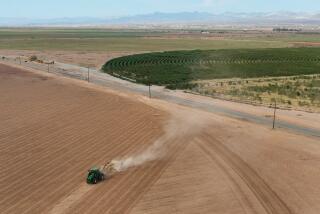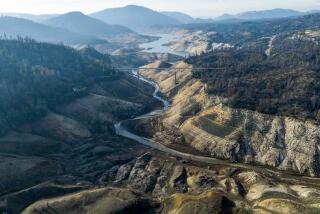Signs Point to Another Dry Winter for Region
Thanks largely to La Nina, it didnât rain much in Southern California last winter, and meteorologists say next winter could be just as dry.
The Civic Center precipitation total for the just-completed meteorological year--which ran from July 1, 1998, through Wednesday--was only 9.09 inches, compared to a normal seasonâs total of 14.77 inches.
Although that was pretty dry, it was nowhere near the record--4.85 inches--set in the 1960-61 season. In fact, since they began keeping records here in July 1877, there have been 25 years drier than last.
But 1998-99 fit the pattern of La Nina years here. The average annual rainfall in Los Angeles of the nine La Nina years since 1949 was 11.33 inches, 3.44 inches below normal.
âAnd this La Nina seems to be holding, with no signs that itâll break down soon,â Steve Pryor, a special services meteorologist with WeatherData Inc., which provides forecasts for The Times, said Wednesday.
âIt probably will last through the end of 1999 and into early 2000, which means that Southern California will have another winter pretty much like the last one,â Pryor said. âIt doesnât look like there will be a lot of heavy rain in Los Angeles in 1999-2000.â
Despite the likelihood of at least two drier-than-normal years in a row in Los Angeles, California is still a long way from a widespread drought, according to officials at the state Department of Water Resources.
As during most La Ninas, rainfall at the northern end of the state has continued to be near or above normal, and Jeff Cohen, a spokesman for the department, said water levels at most major state reservoirs are at or above the usual levels for early July.
Forecasters say the current La Nina oceanic and meteorological phenomenon is the counterpoint to El Nino of 1997-1998, during which 31.03 inches of rain fell on Los Angeles--the third-highest total on record.
Nicholas Graham, a meteorologist with the International Research Center for Climate Predictions at the Scripps Institution of Oceanography in La Jolla, explained that the Pacific Ocean is essentially one vast basin, âwith the water sort of sloshing back and forth.â
He said that during normal conditions, low-level equatorial trade winds blow from east to west, shoving water ahead of them that tends to pile up near Indonesia, raising the sea level there a foot higher than it is off the coast of Peru.
During El Nino, the trade winds slacken or even reverse, and the water sloshes back toward South America. This sloshing surface water presses down on cooler water beneath it that normally wells to the surface off Peru.
As a result, Graham said, the surface water there stays warmer than normal and starts ebbing westward across the Pacific. This vast pool of warmer-than-normal surface water interacts with the atmosphere above it, increasing the storms generated over the central Pacific and amplifying the storm track that funnels precipitation into Southern California.
But El Nino also sows the seeds of its own destruction, setting up ocean and wind currents that ultimately reverse the phenomenon, Graham said. Sometimes, the reversal goes beyond normal, and the surface water off the west coast of Peru becomes abnormally cool. Thatâs whatâs happening now, and itâs called La Nina.
During La Nina, the pool of cooler-than-normal surface water interacts with the atmosphere, again disrupting normal weather patterns. A large ridge of high pressure tends to remain anchored over the northern Pacific, diverting the storm track well north of Southern California.
More to Read
Sign up for Essential California
The most important California stories and recommendations in your inbox every morning.
You may occasionally receive promotional content from the Los Angeles Times.










